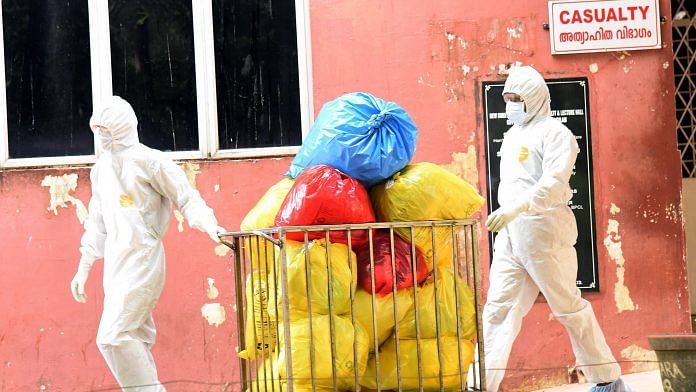New Delhi: High alert has been sounded in Kerala, Karnataka and Tamil Nadu following a fresh outbreak of the Nipah virus in Kerala’s Ernakulam district. A 23-year-old man was confirmed to have contracted the disease on Tuesday. Last year, in an outbreak in the state, the virus had claimed over 21 lives. A total of eight districts in Karnataka and seven in Tamil Nadu have been put on high alert.
The virus can cause neurological and respiratory diseases. It causes influenza-like symptoms and can intensify within 24 to 48 hours. This can further worsen into a coma and eventual death.
ThePrint looks at the causes of this deadly infection and its outbreak in India.
What is Nipah virus and how does it spread?
The World Health Organisation (WHO) defines Nipah as a zoonotic virus: One that is capable of spreading from a host animal, especially fruit bats, to humans. People coming into contact with contaminated fruits can also be affected. The virus also infects animals such as pigs. Person-to-person transmission through contact with infectious body fluids such as nasal droplets while sneezing or coughing can also occur.
The incubation period (which is the interval from infection to the onset of symptoms) may vary from four to 14 days.
The virus was first detected in humans in 1998 when it had claimed the lives of over 100 people in Malaysia. There have been 10 more occurrences, confined to Bangladesh and India with one outbreak reported in Singapore.
Typically, Nipah cases tend to occur in a cluster — among several members of a family or an infected person’s close associates.
Also read: Nipah virus death toll at 10, food safety inspectors to check fruits & vegetables in Kerala
What are its symptoms? Can it be prevented?
The virus can cause a range of illnesses. The initial symptoms of Nipah are very similar to that of influenza which slowly progresses on to encephalitis (inflammation of the brain).
Infected people develop flu-like symptoms such as headache, fever and nausea. Soon, symptoms of encephalitis such as dizziness, confusion, drowsiness or even seizures start to manifest themselves.
At present, there is no established way to treat Nipah virus and only supportive care is available to alleviate symptoms. The disease is not fatal until it affects the brain. The fatality rate is anywhere between 40 per cent to 75 per cent, say doctors.
With no cure at hand, prevention is the key to avoid getting infected with the virus. If there is an outbreak in pigs, an immediate quarantine of those animals is necessary. Often, infected animals would need to be culled to prevent the spread of disease. Thousands of pigs had to be killed in Malaysia after the first outbreak to curb spread of the virus.
Outbreak in Kerala, West Bengal
India has seen Nipah outbreaks in Kerala (2018 and 2019) and West Bengal (2001). Several bats in Assam and Haryana had also tested positive for Nipah virus during the 2018 Kerala outbreak.
The outbreaks can be seasonal — those in Bangladesh and West Bengal took place in the months of January and February while in Kerala the disease surfaced in May-July in 2018 and 2019. More than 2,500 people were infected and over 17 died in Kerala last year.
The Kerala administration’s swift and timely response to the surge in infections last year was commended by many. By July 1, 2018, the state was declared Nipah-free.
The situation now
A total 314 people who were in touch with the infected patient have been kept under observation in Kerala. Six of those have already tested negative for the deadly virus. Laboratory results of another suspect from Pune is expected to be out soon.
No suspected or confirmed cases have been reported from any southern state other than Kerala till date.
Reason for Nipah virus outbreak
We don’t know for sure but one of the primary reasons seem to be habitat loss of fruit bats. The virus has infected bats for centuries but came into contact with humans much later. During the first outbreak in Malaysia, it was observed that bats suffered from habitat loss following deforestation due to demand for pulp wood in the country.
The WHO has categorised illnesses caused by Nipah virus as requiring urgent research and development. In India, Nipah virus can be tested and confirmed at the National Virology Institute in Pune.
Also read: Kerala heaves sigh of relief as 6 test negative for Nipah virus



